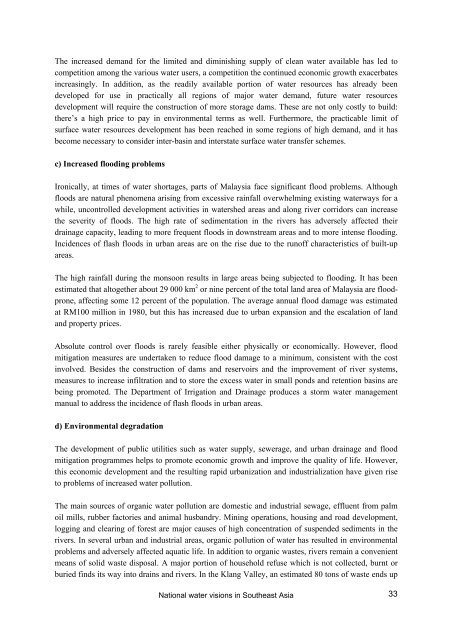The FAO-ESCAP pilot project on national water visions. From vision ...
The FAO-ESCAP pilot project on national water visions. From vision ...
The FAO-ESCAP pilot project on national water visions. From vision ...
Create successful ePaper yourself
Turn your PDF publications into a flip-book with our unique Google optimized e-Paper software.
<str<strong>on</strong>g>The</str<strong>on</strong>g> increased demand for the limited and diminishing supply of clean <strong>water</strong> available has led to<br />
competiti<strong>on</strong> am<strong>on</strong>g the various <strong>water</strong> users, a competiti<strong>on</strong> the c<strong>on</strong>tinued ec<strong>on</strong>omic growth exacerbates<br />
increasingly. In additi<strong>on</strong>, as the readily available porti<strong>on</strong> of <strong>water</strong> resources has already been<br />
developed for use in practically all regi<strong>on</strong>s of major <strong>water</strong> demand, future <strong>water</strong> resources<br />
development will require the c<strong>on</strong>structi<strong>on</strong> of more storage dams. <str<strong>on</strong>g>The</str<strong>on</strong>g>se are not <strong>on</strong>ly costly to build:<br />
there’s a high price to pay in envir<strong>on</strong>mental terms as well. Furthermore, the practicable limit of<br />
surface <strong>water</strong> resources development has been reached in some regi<strong>on</strong>s of high demand, and it has<br />
become necessary to c<strong>on</strong>sider inter-basin and interstate surface <strong>water</strong> transfer schemes.<br />
c) Increased flooding problems<br />
Ir<strong>on</strong>ically, at times of <strong>water</strong> shortages, parts of Malaysia face significant flood problems. Although<br />
floods are natural phenomena arising from excessive rainfall overwhelming existing <strong>water</strong>ways for a<br />
while, unc<strong>on</strong>trolled development activities in <strong>water</strong>shed areas and al<strong>on</strong>g river corridors can increase<br />
the severity of floods. <str<strong>on</strong>g>The</str<strong>on</strong>g> high rate of sedimentati<strong>on</strong> in the rivers has adversely affected their<br />
drainage capacity, leading to more frequent floods in downstream areas and to more intense flooding.<br />
Incidences of flash floods in urban areas are <strong>on</strong> the rise due to the runoff characteristics of built-up<br />
areas.<br />
<str<strong>on</strong>g>The</str<strong>on</strong>g> high rainfall during the m<strong>on</strong>so<strong>on</strong> results in large areas being subjected to flooding. It has been<br />
estimated that altogether about 29 000 km 2 or nine percent of the total land area of Malaysia are floodpr<strong>on</strong>e,<br />
affecting some 12 percent of the populati<strong>on</strong>. <str<strong>on</strong>g>The</str<strong>on</strong>g> average annual flood damage was estimated<br />
at RM100 milli<strong>on</strong> in 1980, but this has increased due to urban expansi<strong>on</strong> and the escalati<strong>on</strong> of land<br />
and property prices.<br />
Absolute c<strong>on</strong>trol over floods is rarely feasible either physically or ec<strong>on</strong>omically. However, flood<br />
mitigati<strong>on</strong> measures are undertaken to reduce flood damage to a minimum, c<strong>on</strong>sistent with the cost<br />
involved. Besides the c<strong>on</strong>structi<strong>on</strong> of dams and reservoirs and the improvement of river systems,<br />
measures to increase infiltrati<strong>on</strong> and to store the excess <strong>water</strong> in small p<strong>on</strong>ds and retenti<strong>on</strong> basins are<br />
being promoted. <str<strong>on</strong>g>The</str<strong>on</strong>g> Department of Irrigati<strong>on</strong> and Drainage produces a storm <strong>water</strong> management<br />
manual to address the incidence of flash floods in urban areas.<br />
d) Envir<strong>on</strong>mental degradati<strong>on</strong><br />
<str<strong>on</strong>g>The</str<strong>on</strong>g> development of public utilities such as <strong>water</strong> supply, sewerage, and urban drainage and flood<br />
mitigati<strong>on</strong> programmes helps to promote ec<strong>on</strong>omic growth and improve the quality of life. However,<br />
this ec<strong>on</strong>omic development and the resulting rapid urbanizati<strong>on</strong> and industrializati<strong>on</strong> have given rise<br />
to problems of increased <strong>water</strong> polluti<strong>on</strong>.<br />
<str<strong>on</strong>g>The</str<strong>on</strong>g> main sources of organic <strong>water</strong> polluti<strong>on</strong> are domestic and industrial sewage, effluent from palm<br />
oil mills, rubber factories and animal husbandry. Mining operati<strong>on</strong>s, housing and road development,<br />
logging and clearing of forest are major causes of high c<strong>on</strong>centrati<strong>on</strong> of suspended sediments in the<br />
rivers. In several urban and industrial areas, organic polluti<strong>on</strong> of <strong>water</strong> has resulted in envir<strong>on</strong>mental<br />
problems and adversely affected aquatic life. In additi<strong>on</strong> to organic wastes, rivers remain a c<strong>on</strong>venient<br />
means of solid waste disposal. A major porti<strong>on</strong> of household refuse which is not collected, burnt or<br />
buried finds its way into drains and rivers. In the Klang Valley, an estimated 80 t<strong>on</strong>s of waste ends up<br />
Nati<strong>on</strong>al <strong>water</strong> visi<strong>on</strong>s in Southeast Asia 33
















